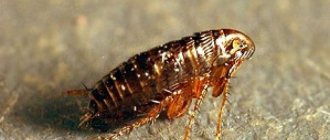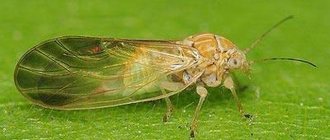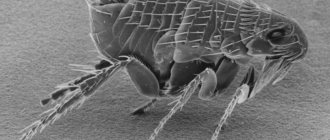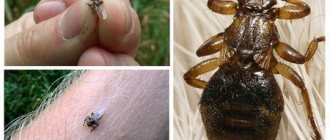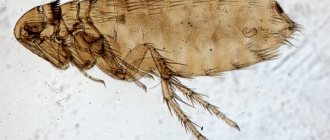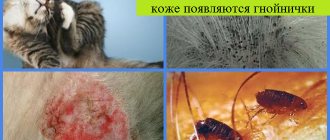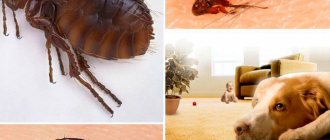Almost every cat owner is familiar with the situation when a pet has fleas (at the same time, the four-legged pet has never left the room in which it lives and has not communicated with its own kind). Read on to find out what these parasites are, where they come from, why they are unpleasant and how to get rid of fleas on a cat.
A flea is a very small insect without wings. It is distinguished by its special jumping ability and mobility. Thanks to their flat body, as if compressed by something, fleas easily avoid external damage - they can almost never be destroyed with your fingers (only if you firmly squeeze them between your nails and crush them). Naturally sharp jaws that dig into the skin of the poor victim are needed to drink blood. Their bites are indeed quite painful.
Causes of fleas
Veterinarians unanimously declare: yes, fleas can appear even in those well-groomed animals that never, under any circumstances, go outside. The owners or their guests can bring them to the house or apartment personally. On clothes and shoes, with the hair of other animals, on children's transport. It only takes one such blood-sucking parasite to get inside the room, and your cat will immediately be attacked.
And although isolation and refusal to walk outside the home does not protect against parasites 100%, they significantly reduce the risk of becoming infected. So, there is an effect from such a precaution. Of course, when an animal is allowed to leave the house, it inevitably interacts with other four-legged animals (house and farm animals), and this risk becomes much higher. Furry participants in exhibitions and “cat” competitions can also pick up the cause of itching in the areas where the events are held.
You should not hope that there will be fewer fleas in winter. Yes, parasites love warm weather, but they also tolerate cold well. Therefore, you can “bring” them in throughout the year. Moreover, the colder it is, the more they strive to get into a person’s home - into the most comfortable living conditions for them. If severe frost kills them, then in the warmth of the house they feel like in paradise.
Fleas, in the absence of a host, whose blood the parasites feed on, fall into a kind of hibernation with a slowdown in vital activity. However, as soon as a victim is identified, they instantly become active.
So the question of fleas in cats is out of season. They are not easy to eliminate, and they pose a threat even to stay-at-home pets.
Preventing the appearance of fleas in the apartment
However, the fight against fleas is not limited to their one-time extermination. There is always the possibility of them getting into an apartment or house again. Also, in multi-storey buildings, warm basements are often the habitat of fleas. If there are a significant number of cat fleas in the basement, you should contact the sanitary and epidemiological station, otherwise the fight against them in the apartment may not bring any results.
To prevent the proliferation of fleas in an apartment, it is necessary to carry out thorough periodic cleaning of places where they may accumulate. Rugs and bedding also need to be washed periodically using insecticidal agents.
It is best to wear an anti-flea collar on your pet - this way the parasites will avoid the cat. Periodically, you should carefully examine the animal for the presence of fleas and, if they appear, immediately take measures to destroy them and disinfect the apartment. You should also be careful when coming into contact with other animals.
How can you tell if a cat has fleas?
You can quickly detect parasites if:
- observe the animal (restless behavior, sharp and frequent reactions to itching, even wounds due to biting into the skin);
- look for traces of the presence of insects (examine the surface of the skin for adults; lower the cat onto a white sheet of paper and comb out the fur or wipe the pet with a white paper towel; if you see black and brown dots, these are traces of flea feces, which turn brown under the influence of a drop of water shade);
- visit a veterinarian (he will accurately determine the presence or absence of fleas).
The likelihood of fleas in four-legged felines increases with dermatitis, hot or pulsating areas on the pet's skin, hair loss or bald patches.
How to determine if a cat is infested with fleas?
Based on the appearance and behavior of the animal, the presence of parasites can be determined by the following primary signs:
- Nervousness and anxiety in the animal’s behavior and lack of normal sleep are noticeable.
- The animal’s appetite is disrupted: it may refuse the food it was accustomed to before.
- The cat itches and often bites itself, thus trying to get rid of annoying parasites.
- A close examination of the animal's undercoat reveals traces of flea excrement.
Traces of flea activity on a cat
How to remove fleas from cats?
It is a mistake to think that regular cleaning of the rooms and thorough bathing of the animal is enough to prevent parasites. Cleanliness is great, but even it does not provide a 100% guarantee that a domestic cat will not have fleas.
All it takes is one single parasite jumping over the threshold for peace and comfort to end. And here's the thing. Fleas reproduce incredibly quickly. Only the first of them leaves behind about fifty eggs a day. And further in a circle. Only two months will pass and one unit of the parasite will turn into a horde of fleas, numbering hundreds or more eggs. This is so terrible that it will no longer be possible to ignore the disaster. And if for some reason you have not poisoned parasites before, then you will have to use all the recommended flea remedies.
Please note that simply treating your pet with a special product will not produce results. Living individuals, their pupae, larvae and eggs are able to hide in beds, pieces of furniture, carpets, clothes and even under baseboards.
According to statistics, adult parasites are only one twentieth of the entire flea population in your home. You simply don’t know about the existence of the remaining 95%, but they are about to turn into an army of pests. And if you don’t destroy them, the problem will soon return in an intensified manner. It is necessary to fight both living parasites and what they lay - eggs, larvae, pupae. And for this it is better to consult a veterinarian or even an exterminator.
Often, in order to remove fleas from a cat at home, it is necessary to carry out cleaning in several approaches. Only then will the animal forget about insects and the living space will become the same. And, of course, remember: the best way to kill fleas is their timely prevention. Treat your four-legged friend with anti-flea products and put a special collar on him.
How to properly put on a flea collar (video)
Examination of the animal
To check if cats have fleas, you need to properly examine the animal by parting the fur. Particular attention is paid to the tail and scruff area. The skin of a healthy animal should be clean, pinkish-white, without scratches, wounds, or crusts.
If scabs and scratches are found, the cat most likely has fleas. Black spots on the skin and fur also indicate the presence of fleas.
Regular inspection of the animal is a measure to prevent flea infestation
Washing cats
Cats should be washed regularly for preventive purposes. For this purpose, you can use regular shampoos designed for bathing cats. Anti-flea shampoo is more effective. It contains essential oils of plants that repel fleas and various types of repellents. This shampoo not only gets rid of fleas, but also creates invisible protection against parasites on the animal’s fur. The smell repels insects and they prefer not to jump on cats.
Cats should be washed regularly for preventive purposes.
Approximately the same effect can be obtained if you use tar soap . In folk medicine, it is considered a very effective remedy against fleas in both humans and animals.
Room cleaning
The house must be thoroughly cleaned every week. Cleaning includes washing floors, cleaning upholstered furniture and interior items from dust. Surfaces should be washed at a height of up to one and a half meters from the floor; it is advisable to use a soap-vinegar solution. This helps to mechanically get rid of flea larvae and create conditions for them that are unacceptable for life. Cleanliness is fleas' number one enemy.
Cleanliness is fleas' number one enemy.
Home treatment
From time to time, you can treat the apartment with some kind of preparation against crawling and jumping insects. It could be:
- "Dichlorvos";
- "Clean house";
- "Combat";
- "Raptor".
The treatment will allow you to destroy accidentally caught fleas and prevent them from multiplying, with the inevitable infection of cats. It is only important to remember that it is better to remove the animal from the house during treatment.
Collars
Collars are:
- with insecticidal chemicals;
- with essential oils;
- ultrasonic repellents.
Ultrasonic collars and products with essential oils are used as preventative measures. Their peculiarity is that they are completely devoid of toxic substances and are absolutely harmless to cats. Ultrasonic collars emit ultrasound at a specific frequency in a range that fleas find unpleasant. Insects are scared away by this sound and do not jump on the animal.
No scratching - no fleas?
Most owners of pets think that if their pet is not bothered by itching, then there are no insects. But the animal may begin to itch only when the parasites are gnawing on it. And while only a few individuals are running on the surface of its skin (which does not last long), it may not show external disturbance. Therefore, you should periodically examine your pet’s fur in order to detect your pet’s enemy at the initial stage of infection. It also happens the other way around, when the cat itches but there are no fleas. A veterinarian will help you find the cause of the itching (allergies, stress or other diseases cannot be ruled out).
So, we found out that the problem of parasites is relevant for all pets at any time of the year. The main thing is to know how to remove fleas from a cat and disinfest the entire living space.
Symptoms of a human being bitten by a cat flea
On the human body, a cat flea bite is recognized by the following signs:
- Fleas, unlike bedbugs, can bite at any time of the day or night.
- Cat flea bites on a person’s body are located no more often than 2-3 cm apart from each other. They can be localized in the area of the arms, back, lower leg, and neck.
- Blisters form in the area of the bite. They swell and take a long time to heal.
- The area around the blister may be itchy and painful.
- The bite is painful because an enzyme in the saliva prevents blood from clotting.
With individual intolerance to the saliva of the parasite, some people, when fleas from cats or dogs are temporarily transmitted to a person, experience a severe allergic reaction.
In this case, antihistamines and ambulance are needed.
How to rid a cat of fleas
There are a huge number of ways to deal with cat fleas. Tar soap is considered the most effective among folk remedies. Regular water procedures with a tar detergent will destroy blood-sucking insects and prevent their appearance.
Industrial products are divided into several categories:
- Anti-flea shampoos contain insecticidal substances or plant extracts that help expel and destroy jumping pests. The product is selected taking into account the cat’s age, health status, and pregnancy. Most shampoos solve the flea problem in one treatment. Lugovoi and Bars are considered effective.
Flea shampoos - Flea drops for cats are the easiest remedy to use. They are available in pipettes with a specific dosage. The product is applied to a place where the pet cannot lick it. Insecticidal substances spread throughout the entire skin, concentrate in the upper layer of the epidermis and have a detrimental effect on fleas. The destruction of parasites occurs within 24 hours. Drops provide long-term protection against repeated flea infestation for 2-3 months. The product has age restrictions and depends on the manufacturer. Depending on this, pet owners can choose the drug at their discretion: 4 with a tail, Frontline, Delix, Rolf Club 3D, Barrier, Dana Ultra Neo, Stronghold, Advantage, Blochnet, Celandine, Helminthal, Inspector and others. You can learn more about their properties at your veterinary pharmacy.
- Flea sprays have a lot in common with drops. The difference between the product is in its application. Sprays are produced in polymer bottles equipped with a spray head. The cat is not bathed 2 days before the procedure. Apply the spray evenly over the entire body according to the instructions in the instructions. Frontline and Bars sprays have proven themselves well. After the product has dried, comb the pet. For 2 days after treatment, the cat is contraindicated in water procedures and contact with other animals.
- Anti-flea collars perform a protective function. The inside of the strap is impregnated with an insecticidal solution, the active substance of which has a detrimental effect on blood-sucking insects. Many people prefer to buy Beaphar, Celandine, Bars collars against cat fleas.
Flea collars
